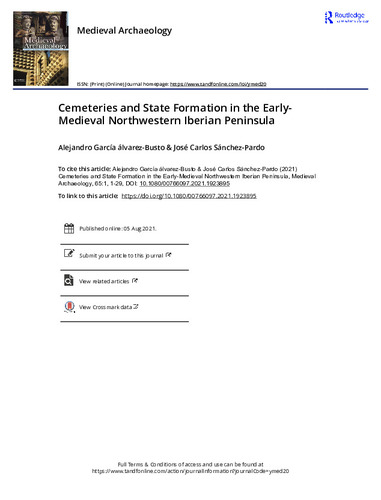Cemeteries and State Formation in the Early-Medieval Northwestern Iberian Peninsula
Autor(es) y otros:
Palabra(s) clave:
Arqueología medieval
Fecha de publicación:
Editorial:
Routledge
Versión del editor:
Citación:
Descripción física:
Resumen:
BASED ON A SIGNIFICANT REVIEW of the literature on early-medieval burials in the Northwestern Iberian Peninsula, this paper aims to offer, for the first time, a comprehensive interpretation of funerary practices and their transformations between the 8th and 10th centuries ad, and to discuss their role as useful indicators of the non-linear processes of state formation in this area. Despite some important regional differences, a general trend toward uniformity and centralised control of funerary behaviours can be detected during this period. However, cemeteries also inform us about the complexity and diversity of social agency at local levels behind the wider trend towards uniformity. It is argued here that both local and regional elites in the Kingdom of Asturias promoted this important change in funerary practices, as they did with the network of churches, given the importance of cemeteries as places of power, and the implications that lay behind the creation and control of a common place of inhumation for local communities.
BASED ON A SIGNIFICANT REVIEW of the literature on early-medieval burials in the Northwestern Iberian Peninsula, this paper aims to offer, for the first time, a comprehensive interpretation of funerary practices and their transformations between the 8th and 10th centuries ad, and to discuss their role as useful indicators of the non-linear processes of state formation in this area. Despite some important regional differences, a general trend toward uniformity and centralised control of funerary behaviours can be detected during this period. However, cemeteries also inform us about the complexity and diversity of social agency at local levels behind the wider trend towards uniformity. It is argued here that both local and regional elites in the Kingdom of Asturias promoted this important change in funerary practices, as they did with the network of churches, given the importance of cemeteries as places of power, and the implications that lay behind the creation and control of a common place of inhumation for local communities.
ISSN:
Patrocinado por:
This study forms part of ASTURMETRÍA research project: Formas de ocupación y organización del espacio en el norte peninsular: el territorio astur entre época antigua y medieval a través del registro arqueológico y paleoambiental, [MINECO-17-HAR2016-78036-P], led by Professor J Avelino Gutiérrez González of the University of Oviedo, and funded by the Ministry of Economy; and of TERPOMED research project: Territorio y poder monástico en la Alta Edad Media, funded by a project of excellence of the Consellería de Cultura, Educación e Ordenación Universitaria de la Xunta de Galicia (PG-065, convocatoria Consolidación e Estructuración 2016). The authors are very grateful to the anonymous reviewers for their useful comments, as well as the editor for her valuable revision of the text and interesting suggestions that have greatly improved the paper. Of course, responsibility for any error remains our own.
Ficheros en el ítem




